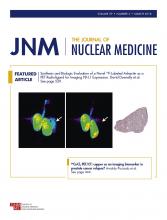TO THE EDITOR: I am writing in support of the editorial written by Dr Czernin (1) and Dr Lam’s letter (2) published recently.
There are 2 questions raised by the statements. The first, should nuclear medicine (NM) be an independent specialty? And second, if not is 16 mo of training adequate to accomplish the best patient care?
My answer is yes to the first question and no to the second. I practiced NM in the United States for 30 y (the last 10 as Director of Nuclear Medicine in a large academic hospital) and assumed leadership positions within the Society of Nuclear Medicine and Molecular Imaging including president of the Nuclear Oncology council between 2009 and 2011. I have returned in 2013 to my native country Lebanon, where a large number of practitioners are duly certified after training in Europe. I have witnessed firsthand the superb quality of their care. Moreover, I have participated at the meetings sponsored by the European Association of Nuclear Medicine and have noticed the excellent educational quality of the talks.
It may be useful to remind the readership of the Journal that NM is an independent specialty in the overwhelming majority of world regions including Europe; the Far East, including China, Japan, and South Korea; and Latin America.
Indeed, there is no compelling reason why NM should be part of Radiology (DR). Although both specialties deal with images, the divergences are more important than the similarities. We look for metabolic or molecular disturbances with the help of tracers. Radiologists look for structural abnormalities (fracture, hemorrhage, edema, and masses) that are detected through changes in physical characteristics of the tissue interrogated. Progress in NM depends mostly on progress in finding more specific tracers. Progress in DR depends on progress in technology and bioengineering. NM has emerged from Medicine everywhere, including the United States, and for this reason has successfully endeavored to quantify the image data and relate them to the patient outcome. NM tests provide not just a diagnosis but also prognostic information and help guide management. It is not surprising that PET is at the forefront of personalized medicine in cancer. I believe our perspective and success are related to our background in Medicine and our affinity with physicians from Medicine.
Finally, and most importantly, the field is moving forward toward therapeutic applications. My mentor, the late Henry Wagner, used to say: “NM is useful for Medicine people and will become increasingly so.” As is often the case, his comments were prophetic. We have emerged from Medicine and we are returning to Medical Therapy, an area far away from radiologist interests and expertise. Therapeutic Interventional Radiology is only an alternative to surgery.
The American pathway is a singular experiment with uncertain results. It is the exception that confirms the rule. It is not a coincidence that this rule has been adopted by the rest of the world. The rule and the correct way are to consider NM as a fully independent specialty. The future will validate this approach and the future is here, that is, Theranostics.
However, because the American NM pioneers have decided otherwise by striking a “marriage” deal with DR, let me answer the second question.
The 16-mo duration is barely adequate for today’s NM and will be inadequate when Theranostics enters practice, in the same way the 4-mo rule (which is still surprisingly valid) was barely adequate for the specialty in the 1970s and has become insufficient when PET entered practice.
In order to support my assertion, I compared the duration of training of future specialists in Europe and elsewhere. It is 4–5 y and includes cross-sectional anatomy and basics of CT. It takes a maximum of 12 mo to learn these 2 areas. Therefore, a 1-y credit can be given to physicians coming from DR, resulting in a 36-mo training duration. A similar comparison with NM residency in the United States would result in a 24-mo training.
Finally, I ask myself (and the readers) this question. How do you expect a radiologist who learned everything in NM in 16 mo to treat and follow a metastatic castrate-resistant prostate cancer patient candidate for radionuclide therapy?
The leadership of the American Board of Nuclear Medicine should reconsider the 16-mo rule and extend it appropriately. Otherwise, the practice of NM in the United States will remain limited to diagnostic procedures with the exception of a few large academic centers. Who will suffer most? The American patient.
Footnotes
Published online Dec. 21, 2017.
- © 2018 by the Society of Nuclear Medicine and Molecular Imaging.







